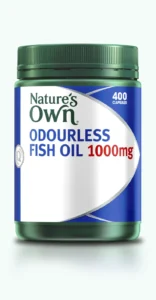
Benefits of omega-3 fatty acids
In this article
What are omega-3 fatty acids?
Omega-3 fatty acids are a type of fatty acid essential to your overall health and wellbeing. There are several types of fatty acids found in your diet and they all play a part in your health — some good, some bad, these include:
- Saturated Fat — Saturated fats are fats that are usually solid at room temperature. These include foods like butter, palm and coconut oils, cheese, and red meat1.
- Unsaturated fats — Unsaturated fats are liquid at room temperature and include polyunsaturated fats (PUFAs) and monounsaturated fats1.
- Monounsaturated fats include nuts, avocado, canola oil, olive oil, safflower oil, sunflower oil, peanut oil and butter and sesame oil.
- Polyunsaturated fats include omega-6 fatty acids and omega-3 fatty acids.
- Trans fatty acids — Trans fatty acids are found naturally in small amounts in beef and dairy fat. Trans fatty acids are also in hydrogenated vegetable oils. To produce a stable, long-lasting cooking oil for baking and deep-frying vegetable oils are hydrogenated to form a solid fat. In excess, these hydrogenated oils lead to adverse effects on cholesterol2. Its recommended that you avoid these in your diet. Avoid ingredients such as partially hydrogenated vegetable oils or partially hydrogenated oil.
Getting the balance of fats right in your diet
There is an overwhelming amount of information on which fats are ‘good’ and which fats are ‘bad’ in your diet. The important thing to focus on is that all fats are needed, they’re just needed in the right balance.
The Australian government recommends getting 20–35% of your energy from fats in your diet3. That is about 44 grams to 77 grams of fat per day if you eat 2,000 calories a day.
A suggestion of how you could break down your fat consumption per day would look like this.4,5
- Monounsaturated fat: 15% to 20%
- Polyunsaturated fat: 5% to 10%
- Saturated fat: less than 10%
- Trans fat: 0%
The breakdown of fats in your diet would be different for each individual, depending on your circumstances. Your healthcare practitioner can advise you on which fats to include in your diet to reduce inflammation.
Keeping fats in balance can be difficult when you are following a modern diet based on refined foods with hidden trans fats and fast foods laden with saturated fats. Getting enough polyunsaturated fats, especially omega-3 fatty acids, can be difficult.
Polyunsaturated Fats
Polyunsaturated fats include omega-3 and omega-6 fatty acids and are essential for human health6. Your body can’t make these fats, so you need to eat polyunsaturated fats in your diet.
Omega-6 fatty acids
Omega-6 fatty acids are needed for healthy well-being. Omega-6 fatty acids include2,7, 8
- Linoleic acid (LA) — LA is in vegetable oils and safflower oil.
- Gamma linoleic acid (GLA) — GLA is in oils selected plant oils such as evening primrose oil, blackcurrant seed oil, borage seed oil, and hemp seed oil.
- Dihomo-gamma-linolenic acid (DGLA) — DLGA results from the conversion of GLA.
- Arachidonic Acid (AA) — AA is found in meat, poultry and eggs.
Omega-3 fatty acids
There are three main types of omega-3 fatty acids: Eicosapentaenoic acid (EPA), Docosahexaenoic acid (DHA) and alpha-Linolenic Acid (ALA).
The body can take ALA from your diet and convert it to DHA and EPA, but only in small amounts, so it’s important to include foods high in EPA & DHA in your diet.
What do omega-3 fatty acids do in the body?
Omega-3s and your cells
Omega-3 fatty acids are essential structural components of cell membranes.
Omega-3s and your eyes
High concentrations of DHA are found in the cell membranes of the retina in your eye. The retina also conserves and recycles DHA even when dietary intake is low. Research shows that DHA is needed by the brain to convert the light that hits the retina into a visual image9.
Omega-3s and your brain
The brains grey matter contains high proportions of DHA. DHA also helps support memory and learning. The availability of omega-3 fatty acids to growing babies and infants is essential for the growth of their brain and the development of brain functions.
Omega-3s and your heart
Omega-3 fatty acids benefit your cardiovascular system10:
Signs of omega-3 fatty acid deficiency
The initial clinical signs of omega-3 fatty acid deficiency can include11:
- Dry scaly rash
- Decreased growth in infants and children
- Increased susceptibility to infection
- Poor wound healing
How do I get enough Omega-3 fatty acids?
Fortunately, it’s relatively easy to ensure that you consume enough omega-3 fatty acids in your daily diet.
EPA and DHA
Sources of EPA and DHA include9:
- Oily fish — Including Salmon, tuna, trout, mussels, oysters, cod, fish eggs, pickled herring, and clams.
alpha-Linolenic acid
Sources of ALA include12:
- Plant oils — Plant oils such as flaxseed oil, canola oil and soybean oil.
- Legumes — Legumes, including edamame and navy beans.
- Grains — Grains, including whole-wheat bread and oatmeal.
- Seeds — Seeds, including chia seeds, hemp seeds and flaxseeds.
Fish Oil Supplements
Fish oil supplements are readily available if your dietary intake of omega-3 fatty acids is inadequate. There are a variety of formulas available depending on your needs.
Concentrated formulas make taking higher doses easier and are beneficial for people requiring higher therapeutic dosages. Odourless products can help reduce fishy aftertaste.
Look for fish oils from ocean-caught wild fish that are tested for pesticides and heavy metals, to ensure you are receiving high-quality fish oil.
Sustainable sources of fish oil
The fish used in the manufacture of Nature’s OwnTM fish oil products are sourced from the cold waters of the deep sea and include fish such as mackerel, sardines, anchovies, herring and salmon. These are sustainably harvested from pristine waters off the coast of South America, according to strict industry regulations.
References
[1] https://www.hsph.harvard.edu/nutritionsource/what-should-you-eat/fats-and-cholesterol/types-of-fat/
[2] https://www.foodstandards.gov.au/consumer/nutrition/transfat/pages/default.aspx
[3] https://www.nrv.gov.au/chronic-disease/macronutrient-balance
[5] https://medlineplus.gov/ency/patientinstructions/000785.htm
[6] https://lpi.oregonstate.edu/mic/other-nutrients/essential-fatty-acids
[7] Fan Y, Chapkin R. Importance of Dietary γ-Linolenic Acid in Human Health and Nutrition. The Journal of Nutrition. 1998;128(9):1411-1414.
[8] https://ods.od.nih.gov/factsheets/Omega3FattyAcids-HealthProfessional/#h2
[9] SanGiovanni J, Chew E. The role of omega-3 long-chain polyunsaturated fatty acids in health and disease of the retina. Progress in Retinal and Eye Research. 2005;24(1):87-138.
[10]https://medlineplus.gov/ency/patientinstructions/000767.htm
[11] Jeppesen P, Høy C, Mortensen P. Essential fatty acid deficiency in patients receiving home parenteral nutrition. The American Journal of Clinical Nutrition. 1998;68(1):126-133.




